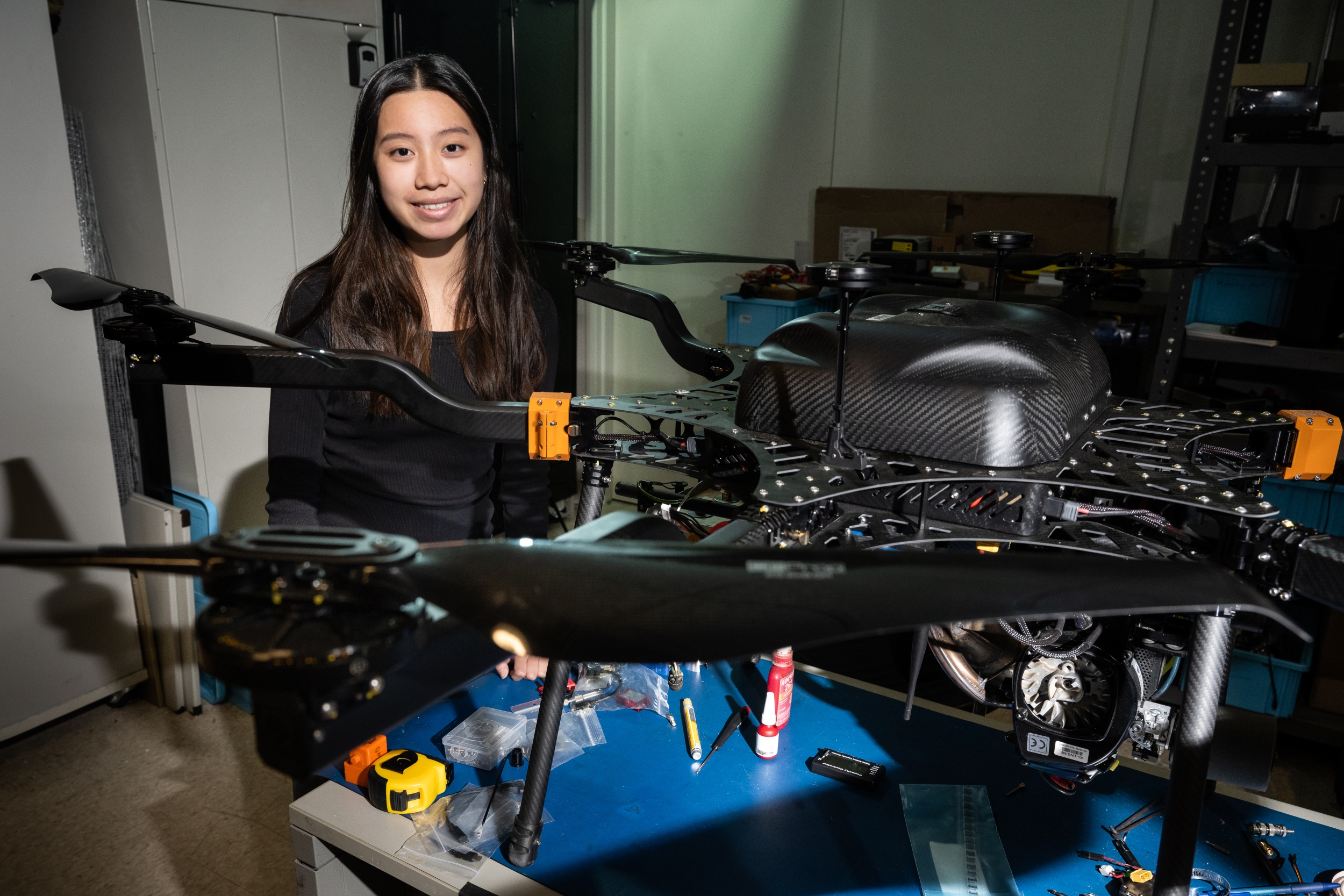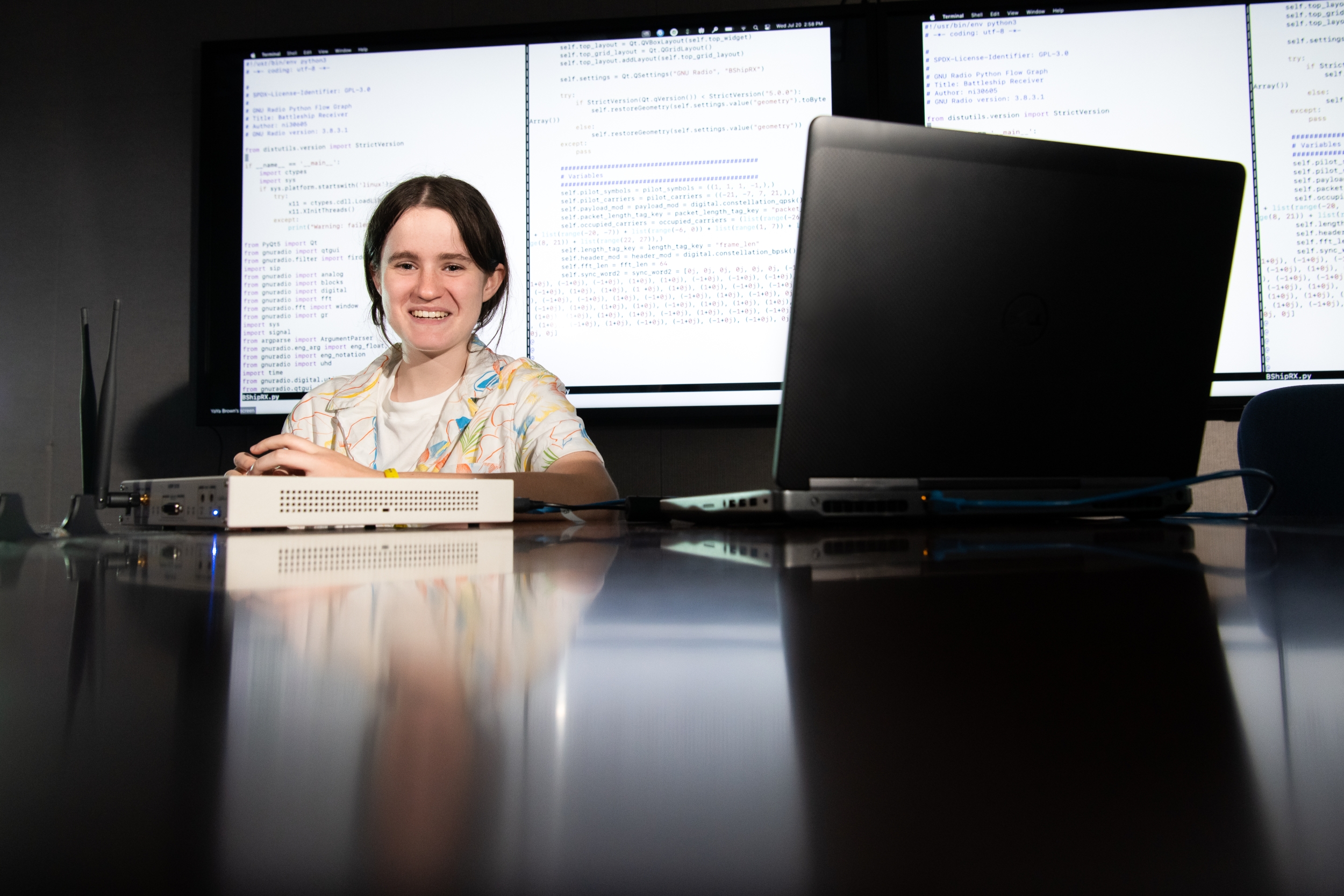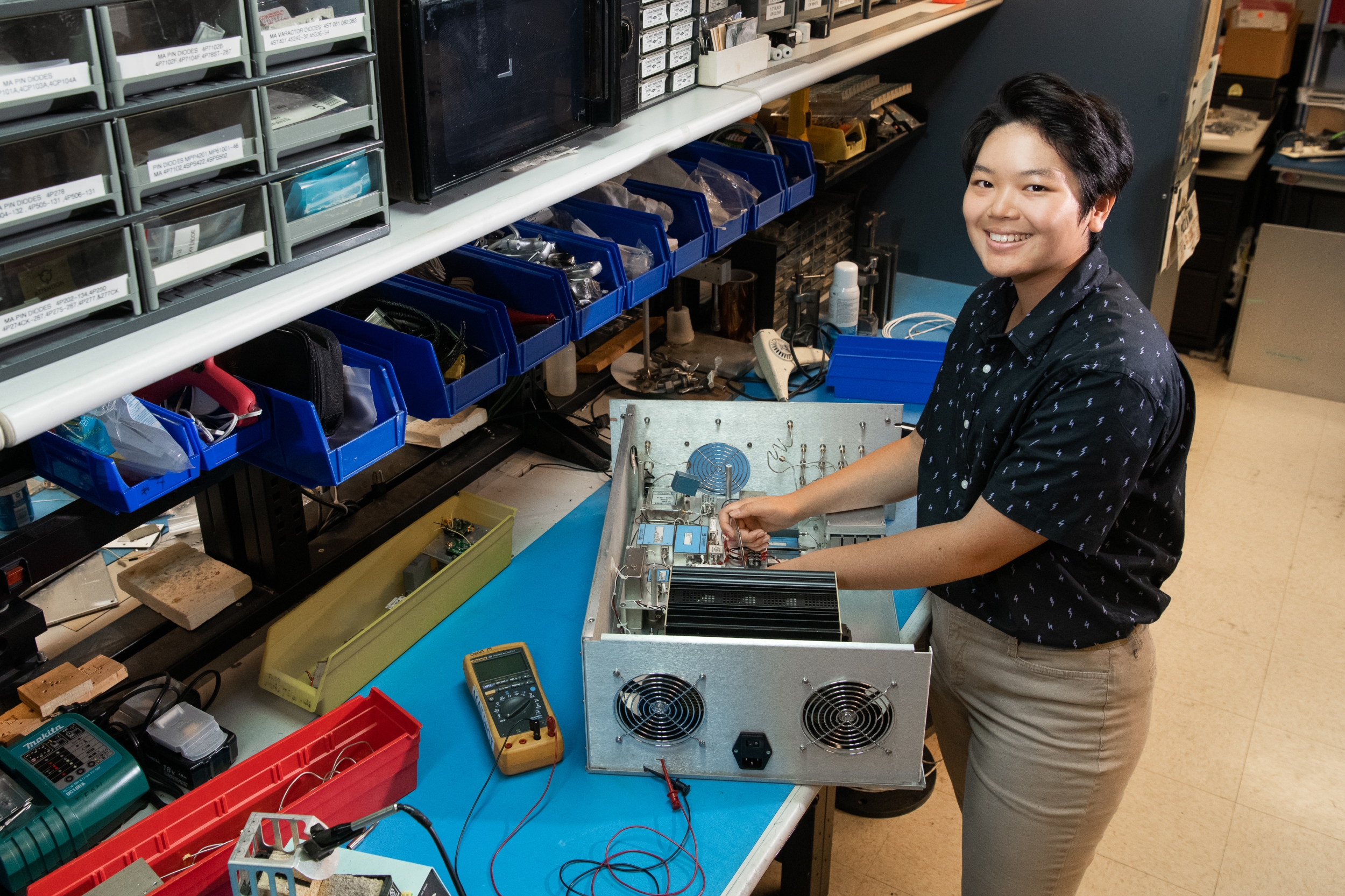Lincoln Laboratory launches summer internships for local high schoolers
Every summer, hundreds of students come to Lincoln Laboratory to gain hands-on research experience. Historically, the Laboratory’s summer research program has primarily served undergraduate and graduate students, with their internships complementing their fields of study. A few local high school students have participated in this program over the years through AFCEA International, a nonprofit providing educational and networking opportunities. But this summer, as the Laboratory re-opened its doors for the first time in years since the COVID-19 pandemic began, the program was officially expanded to offer on-site internships for local high schoolers.
“The internships provide students with an opportunity to explore STEM careers while they're still in high school, before they commit to an area of study in college,” says Gary Hackett, who manages the Laboratory’s campus recruiting program, summer research program, and now the new high school internship program, in collaboration with human resources administrator Cheryl Bartolone and K–12 STEM outreach coordinator Chiamaka Agabsi-Porter and K–12 STEM outreach administrator Daphne-Ann Vessiropoulos. “This opportunity goes beyond engaging in hands-on research to include mentoring on educational and career paths, developing interpersonal skills in a professional workplace environment, and networking with staff across the Laboratory. Following their experience, hopefully students will consider the Laboratory as a place for future employment.”
Agbasi-Porter and Vessiropoulos helped spread the word about the new opportunity to local-area high schools whom they had already established partnerships with through two STEM programs they lead: Lincoln Laboratory Radar Introduction for Student Engineers (LLRISE) and Lincoln Laboratory Cipher (LLCipher). The initial application round was highly competitive; more than 100 high schoolers applied. Ultimately, Laboratory staff selected four interns for the inaugural six-week program, which ran from July 6 to August 12. To align the internships with student interests, staff accordingly placed the interns in Laboratory research groups.
Inaugural interns
"During the interview process, I explained my interest in helping the environment," says Chloe Kindangen, a rising senior at Philips Academy in Andover, Massachusetts. "I grew up in Jakarta, Indonesia, and the skies would always be really dark because of the factories. All the rivers are quite polluted, and it's heartbreaking to see because a lot of people depend on those waters for bathing and cooking. With the privilege of my education, I want to give back to my community."

This summer, Kindangen interned in the Laboratory's Advanced Sensor Systems and Test Beds Group, which develops radar, optical systems, and airborne surveillance platforms. Aggregating data from online sources, she assessed the environmental impacts of drones operating at the Pacific Missile Range Facility at Makaha Ridge in Hawaii. In particular, she researched the impacts on wildlife and considered how to mitigate risks posed by stimuli such as light and noise. Possible mitigations include changing the color of lights the drone uses and avoiding testing during critical times, like bird nesting season, as fledglings are more sensitive to light.
From her experience, Kindangen realized she enjoys conducting this kind of research as opposed to hands-on lab-based projects. She remains interested in continuing on the environmental path, with plans to register for her school's environmental science class in the upcoming school year. Kindangen also took advantage of other opportunities at the Laboratory, including its introduction to radar course, which sparked her interest in deriving math equations that represent real-world situations.
"Coming out of this experience, I know I definitely want to do something STEM related that involves reading through reports, understanding what they mean, and seeing where and how I can fill in the gaps," says Kindangen. "In talking to some college interns on site, I realized I had this misconception that as a senior I should know exactly what major I want to declare and how it translates to a professional field. I now plan to attend a college with a core curriculum so I can expose myself to different fields and make sure I enjoy my major."
Kindangen's mentor, Robert Natividad, sees the benefit of offering internships at this educational stage: "High school is an ideal time for students to have informative experiences that help them refine their understanding of where they would like to go in the future."
Even for students who have already been exposed to a field of interest through classes or extracurricular activities, the internships enable them to experience the field in a professional workplace setting.
"I've been wanting to get more into electrical engineering," says Mya Gordon, a rising senior at Lexington High School in Lexington, Massachusetts. "I've taken one robotics class, participate in a robotics club outside of school, and do programming independently. The Laboratory's internship program allowed me to apply these things to real projects and expose myself to different subfields and applications of electrical engineering."
This summer, Gordon interned in the Tactical Networks Group, where researchers develop communication systems capable of effectively operating in congested and contested environments. She programmed a receiver for a wireless communications–based Battleship-like game, which the group will demonstrate at the Laboratory's Open House event in September. Her two mentors, YaYa Brown and Nicholas Smith, provided a general overview of what she needed to do, but it was up to Gordon to structure and write the code. As Gordon explains, the game is a version of Battleship, but instead of ships existing at a certain location on a grid, their location is translated into a particular frequency and time. If an opponent sends a signal at that same frequency and time, they'll jam any messages coming from the ship.

"I've learned a lot about software-defined radios and object-oriented programming," says Gordon. "My experience this summer solidified my desire to go to a college that offers internships and co-ops and pursue a STEM degree involving both hardware and software elements."
Veronica Cheng, a rising senior at Westford Academy, felt proud about what she accomplished in a short amount of time. She came into her internship in the Advanced Concepts and Technologies Group — whose expertise is developing radar, electronic warfare, and system-of-systems technologies for air and missile defense — with limited knowledge of radars and not having taken any calculus courses. Mentor Kristan Tuttle helped bring her up to speed, and, on her own, Cheng read technical documentation on radars and user manuals for assembling evaluation boards with the firmware necessary for testing a thumb-size car radar. Armed with this knowledge, Cheng performed calculations needed to test the range of this radar. A corner reflector — a structure made of perpendicular, intersecting flat surfaces — served as the test target.
"I moved the corner reflector away from the radar at different distances to see when and where it would show up," explains Cheng. "I had to figure out the dimensions of the reflector that would be compatible with the radar and interpret my results from the radar graphs I generated. I really like math and figuring out how things work based on calculations."

For Cheng, the internship confirmed electrical engineering is the major she intends to pursue in college. Like Gordon, she had some exposure to the field through her participation on a robotics team, but she didn't know what it would entail in the real world.
Beyond the technical knowledge they acquired, the high schoolers developed a new set of social skills, particularly in networking with other interns and staff and presenting their research. Like the college summer research interns, the high schoolers were invited to several events, including presentations from the Laboratory’s research divisions; a National Intern Day celebration; the I3C (for Intern Innovative Idea Challenge) shark tank, where teams of summer research students at the college level present their ideas to a judging panel of Laboratory leadership; and an end-of-summer breakfast to engage with fellow interns. Their mentors also took them on tours of Laboratory facilities and hosted lunch get-togethers with other group staff.
Mentor reflections
Students weren't the only ones who benefitted from the experience. The mentors note how mentoring enabled them to enhance their communication skills, reignite their passion for their respective field, and consider problems from new perspectives.
"It's been rewarding to learn how to define a problem for someone in a way that makes sense for them," says Brown.
"Serving as mentors challenged us to make topics we work on, which almost always require a college education, accessible to a high schooler," says mentor Robert Palladino.
"Seeing our work through an intern's eyes is a good reminder of how exciting and interesting it is," adds mentor Elisheva Shuter. "It's cool to hear ideas totally out of the box and be asked questions that get us thinking, too."
Though the internships have concluded, they are only the beginning of what the Laboratory hopes will be long-term interaction and engagement. "We aim to maintain relationships with the students over time, with groups encouraged to keep in touch with their mentees," says Hackett. In future years, the goal is to expand the program, recruiting more mentors across all of the Laboratory's R&D areas to serve more students.
For more information about the summer high school internship program, contact Gary Hackett or visit the program website.
Inquiries: contact Ariana Tantillo.